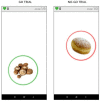A community-based feasibility randomized controlled study to test food-specific inhibitory control training in people with disinhibited eating during COVID-19 in Italy
- PMID: 35666376
- PMCID: PMC9169443
- DOI: 10.1007/s40519-022-01411-9
A community-based feasibility randomized controlled study to test food-specific inhibitory control training in people with disinhibited eating during COVID-19 in Italy
Abstract
Purpose: The aim of this study was to expand the evidence on the feasibility and impact of food-specific inhibitory control training in a community sample of people with disinhibited eating.
Methods: Recruitment and data collection were conducted during the COVID-19 outbreak, in Italy. Ninety-four adult individuals with disinhibited eating were randomised to one of two conditions: App-based food-specific inhibitory control training or waiting list. Participants were assessed at baseline, end of intervention (2 weeks following baseline) and follow-up (one week later). The assessment measures included questionnaires about eating behaviour and mood.
Results: Seventy-three percent of the sample reported a diagnosis of binge eating disorder, and 20.4% a diagnosis of bulimia nervosa. Retention rates were 77% and 86% for the food-specific inhibitory control training and the waiting list conditions, respectively. Almost half of the participants allocated to the training condition completed the "recommended" dose of training (i.e., 10 or more sessions). Those in the training condition reported lower levels of wanting for high-energy dense foods (p < 0.05), a trend for lower levels of perceived hunger (p = 0.07), and lower levels of depression (p < 0.05). Binge eating symptoms, disinhibition, wanting for high-energy dense foods, stress and anxiety were significantly lower at end of intervention, compared to baseline (p < .05).
Conclusion: Findings corroborated the feasibility of food-specific inhibitory control training, and its impact on high-energy dense foods liking. The study expands the evidence base for food-specific inhibitory control training by highlighting its impact on perceived hunger and depression. The mechanisms underlying these effects remain to be clarified.
Level of evidence: Level I, Evidence obtained from at least one properly designed randomized controlled trials; systematic reviews and meta-analyses; experimental studies.
Keywords: App; Binge eating; Bulimia nervosa; Depression; Food addiction.
© 2022. The Author(s).
Conflict of interest statement
The authors have no relevant financial or non-financial interests to disclose.
Figures





References
Publication types
MeSH terms
Grants and funding
LinkOut - more resources
Full Text Sources
Medical
Research Materials

